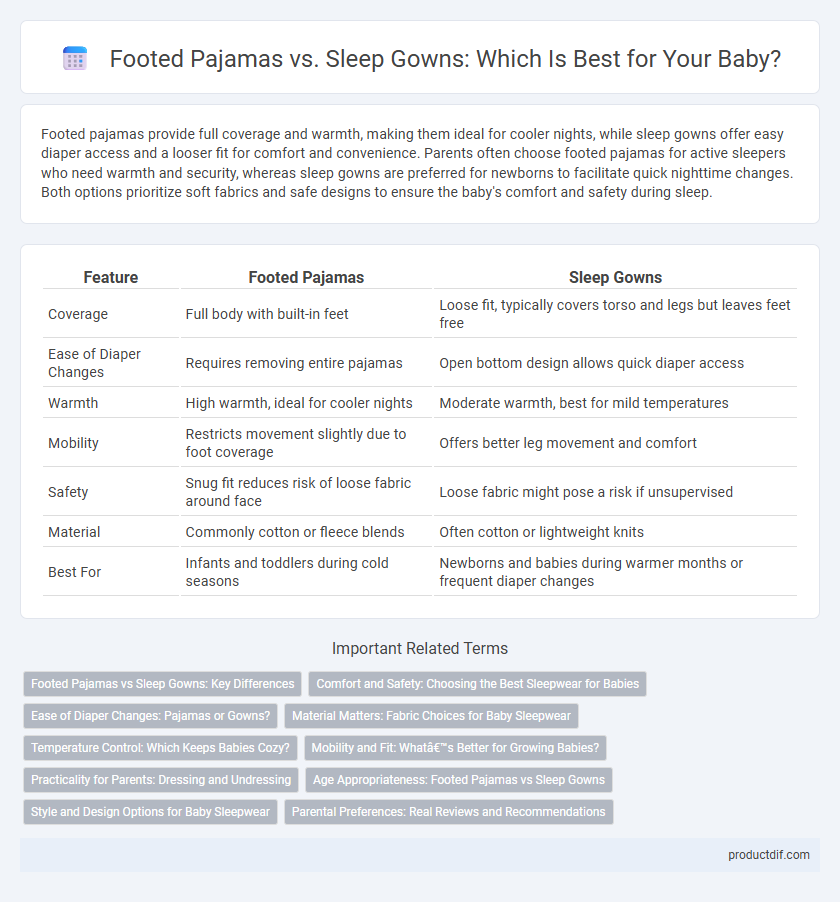Footed pajamas provide full coverage and warmth, making them ideal for cooler nights, while sleep gowns offer easy diaper access and a looser fit for comfort and convenience. Parents often choose footed pajamas for active sleepers who need warmth and security, whereas sleep gowns are preferred for newborns to facilitate quick nighttime changes. Both options prioritize soft fabrics and safe designs to ensure the baby's comfort and safety during sleep.
Table of Comparison
| Feature | Footed Pajamas | Sleep Gowns |
|---|---|---|
| Coverage | Full body with built-in feet | Loose fit, typically covers torso and legs but leaves feet free |
| Ease of Diaper Changes | Requires removing entire pajamas | Open bottom design allows quick diaper access |
| Warmth | High warmth, ideal for cooler nights | Moderate warmth, best for mild temperatures |
| Mobility | Restricts movement slightly due to foot coverage | Offers better leg movement and comfort |
| Safety | Snug fit reduces risk of loose fabric around face | Loose fabric might pose a risk if unsupervised |
| Material | Commonly cotton or fleece blends | Often cotton or lightweight knits |
| Best For | Infants and toddlers during cold seasons | Newborns and babies during warmer months or frequent diaper changes |
Footed Pajamas vs Sleep Gowns: Key Differences
Footed pajamas provide full-body coverage with built-in feet, ensuring warmth and reducing the risk of loose fabric around infants, while sleep gowns offer an open-bottom design for easy diaper changes and better airflow. Footed pajamas often feature snug fits and secure closures like zippers or snaps, enhancing comfort and preventing slipping, whereas sleep gowns prioritize convenience and unrestricted leg movement. Choosing between footed pajamas and sleep gowns depends on factors such as nighttime warmth needs, ease of diaper access, and the baby's age or mobility level.
Comfort and Safety: Choosing the Best Sleepwear for Babies
Footed pajamas provide full coverage and warmth, reducing the risk of chills and keeping babies cozy throughout the night, while also preventing loose fabric that could pose a safety hazard. Sleep gowns offer easy diaper access and greater airflow, promoting comfort in warmer climates but may lack the snug fit that minimizes movement-related risks. Prioritizing soft, breathable fabrics with secure closures ensures optimal comfort and safety in choosing the best sleepwear for babies.
Ease of Diaper Changes: Pajamas or Gowns?
Footed pajamas offer snap closures along the legs, enabling quick and easy diaper changes without fully undressing the baby, which is especially convenient during nighttime. Sleep gowns provide an even simpler solution with their wide openings at the bottom, allowing parents to change diapers swiftly without removing the entire garment. Both options enhance diaper-changing efficiency but sleep gowns typically allow faster access compared to footed pajamas.
Material Matters: Fabric Choices for Baby Sleepwear
Footed pajamas often use soft cotton, fleece, or bamboo fabrics that offer warmth and breathability, making them ideal for colder nights and ensuring baby comfort. Sleep gowns typically feature lightweight cotton or muslin, promoting airflow and easy diaper changes for warmer climates. Choosing breathable, hypoallergenic materials is essential for preventing irritation and maintaining safe, comfortable sleep conditions for infants.
Temperature Control: Which Keeps Babies Cozy?
Footed pajamas provide full-body coverage with built-in feet, offering better insulation and consistent warmth, ideal for cooler temperatures. Sleep gowns allow more airflow and easier diaper changes but may not retain heat as effectively, making them suitable for mild or warmer climates. Choosing the right option depends on the baby's room temperature and the need for temperature regulation to keep babies cozy and safe during sleep.
Mobility and Fit: What’s Better for Growing Babies?
Footed pajamas provide a snug fit that keeps babies warm and secure while allowing for limited mobility due to their enclosed feet, making them ideal for younger infants who are less active. Sleep gowns offer greater freedom of movement with loose, open-bottom designs, which accommodate rapid growth and make diaper changes easier for more mobile babies. Choosing between the two depends on the baby's developmental stage and need for unrestricted leg movement during sleep and play.
Practicality for Parents: Dressing and Undressing
Footed pajamas offer ease for parents with their all-in-one design, allowing quick dressing and undressing without the need to match separate pieces. Sleep gowns feature elastic or open bottoms that simplify diaper changes, making them a practical choice for nighttime care. Both options prioritize convenience, but footed pajamas provide full coverage, while sleep gowns offer faster access for nighttime diaper changes.
Age Appropriateness: Footed Pajamas vs Sleep Gowns
Footed pajamas are ideal for infants and young toddlers up to 24 months due to their full coverage and built-in footies that keep babies warm during sleep. Sleep gowns are better suited for newborns and younger babies under 6 months, offering easy diaper access and comfort. Choosing the right sleepwear depends on the child's age, mobility, and need for warmth or convenience during nighttime changes.
Style and Design Options for Baby Sleepwear
Footed pajamas offer full coverage with built-in feet, providing warmth and preventing socks from slipping off, ideal for cooler nights and active sleepers. Sleep gowns feature an open bottom for easy diaper changes and increased airflow, making them a convenient choice for newborns and warmer climates. Both styles come in various fabrics, prints, and colors, allowing parents to select baby sleepwear that balances comfort, practicality, and aesthetic appeal.
Parental Preferences: Real Reviews and Recommendations
Parents frequently choose footed pajamas for newborns due to their full-body warmth and secure fit, which minimizes the risk of uncovered skin during sleep. Sleep gowns, favored for their easy diaper access and breathable design, appeal especially during warmer months or for quick nighttime changes. Real reviews highlight comfort, convenience, and safety as the primary factors influencing parental preferences, with many recommending a seasonal rotation between both styles to balance warmth and ease.
Footed Pajamas vs Sleep Gowns Infographic

 productdif.com
productdif.com